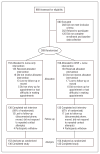A randomized controlled trial of asthma self-management support comparing clinic-based nurses and in-home community health workers: the Seattle-King County Healthy Homes II Project
- PMID: 19188646
- PMCID: PMC2810206
- DOI: 10.1001/archpediatrics.2008.532
A randomized controlled trial of asthma self-management support comparing clinic-based nurses and in-home community health workers: the Seattle-King County Healthy Homes II Project
Abstract
Objective: To compare the marginal benefit of in-home asthma self-management support provided by community health workers (CHWs) with standard asthma education from clinic-based nurses.
Design: Randomized controlled trial.
Setting: Community and public health clinics and homes.
Participants: Three hundred nine children aged 3 to 13 years with asthma living in low-income households.
Interventions: All participants received nurse-provided asthma education and referrals to community resources. Some participants also received CHW-provided home environmental assessments, asthma education, social support, and asthma-control resources.
Outcome measures: Asthma symptom-free days, Pediatric Asthma Caretaker Quality of Life Scale score, and use of urgent health services.
Results: Both groups showed significant increases in caretaker quality of life (nurse-only group: 0.4 points; 95% confidence interval [CI], 0.3-0.6; nurse + CHW group: 0.6 points; 95% CI, 0.4-0.8) and number of symptom-free days (nurse only: 1.3 days; 95% CI, 0.5-2.1; nurse + CHW: 1.9 days; 95% CI, 1.1-2.8), and absolute decreases in the proportion of children who used urgent health services in the prior 3 months (nurse only: 17.6%; 95% CI, 8.1%-27.2%; nurse + CHW: 23.1%; 95% CI, 13.6%-32.6%). Quality of life improved by 0.22 more points in the nurse + CHW group (95% CI, 0.00-0.44; P = .049). The number of symptom-free days increased by 0.94 days per 2 weeks (95% CI, 0.02-1.86; P = .046), or 24.4 days per year, in the nurse + CHW group. While use of urgent health services decreased more in the nurse + CHW group, the difference between groups was not significant.
Conclusion: The addition of CHW home visits to clinic-based asthma education yielded a clinically important increase in symptom-free days and a modest improvement in caretaker quality of life.
Figures
References
-
- Akinbami L. The State of Childhood Asthma, United States, 1980–2005: Advance Data From Vital and Health Statistics [No. 381] Hyattsville, MD: National Center for Health Statistics; 2006. - PubMed
-
- Clark NM, Feldman CH, Evans D, Levision MJ, Mellins RB. The impact of health education on frequency and cost of health care use by low income children with asthma. J Allergy Clin Immunol. 1986;78(1 pt 1):108–115. - PubMed
-
- Fireman P, Friday GA, Gira C, Vierthaler WA, Michaels L. Teaching self-management skills to asthmatic children and their parents in an ambulatory care setting. Pediatrics. 1981;68(3):341–348. - PubMed
-
- Lewis CE, Lewis M, De la Sota A, Kaplan M. A randomized trial of A.C.T. for Kids. Pediatrics. 1984;74(4):478–486. - PubMed
-
- Wilson SR, Latini D, Starr NJ, et al. Education of parents of infants and very young children with asthma: a developmental evaluation of the Wee Wheezers program. J Asthma. 1996;33(4):239–254. - PubMed


